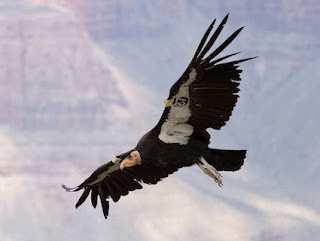California Condor
November 10, 2017
 | ||
| https://www.allaboutbirds.org/guide/PHOTO/LARGE/coca2_nedharris.jpg |
Description and Ecology of California Condors
The California Condor, also known as Gymnogyps californianus, is the largest bird found in North America. Once the proud champion of the western sky, the condor boasts a wingspan of nine and a half feet, black feathers, and a bald head, with white patches coloring the underside of its wings. The California Condor can reach maximum speeds of 55 miles per hour, or 88 kilometers per hour, and weighs 16 to 25 pounds on average. They can reach altitudes of 15,000 feet during flight, or 4,600 meters. These condors live in rocky, forested regions such as canyons and gorges and tend to nest high up on cave openings and cliff ledges. Condors are a scavenging, vulture species, meaning that they feed on the remains of already dead animals, known as carrion, and do not prey themselves. This scavenger lifestyle means that these condors can live up to 60 years in the wild. Their current habitat range spans California's southern coast from Big Sur to Ventura County. |
| https://www.fws.gov/cno/es/calcondor/CACO-ReleaseSites.jpg |
Geographic Changes
Once considered sacred by western Native Americans, the California Condor experienced population decline for a host of possible reasons, although scientists are not completely sure of the exact cause of the decline. Among the factors that influenced the negative trend are poison ingestion, illegal collection of the birds' eggs by humans, and loss of the prehistoric herds of animals that once roamed and provided sustenance for the species. Human intolerance of the species, development projects that destroy habitats, and lead poisoning from the scavenging of animals killed by poachers' firearms have all contributed to the drastic decline as well.
Population Changes
 |
| http://blog.sandiegozooglobal.org/wp-content/ uploads/2013/12/California_condor_winspread.jpg |
The total population of California Condors has declined from large and healthy in the time of European exploration of North America to an estimated 9 to 22 total surviving members of the species in 1985. In the condor's 1996 recovery plan, the population is stated to have risen to 103 total in Southern California.
In 2010, California Condor population reports tracked more than 370 birds in the total population, and by 2016 there were officially more than 446 condors in the world, with an estimated 230 residing in the wild.
Listing
The California Condor was officially listed as a United States federally endangered species on March 11, 1967. It was later listed as "Experimental Population, Non-Essential" on October 16, 1996 for the specific regions of Arizona, Nevada, and Utah.
Cause of Listing and Main Threats
The leading threats to the California Condor are lead poisoning and shooting, and these two crucial factors led to the federally endangered status of the species in 1967. Other crucial threats include habitat destruction and illegal condor egg collection.
Description of Recovery Plan
The 1996 California Condor recovery plan's objective is to downlist the species from being considered endangered to threatened. The plan classifies its criteria of success as "maintenance of at least two non-captive populations and one captive population" in which "each number at least 150 individuals", "contain at least 15 breeding pairs", and are "reproductively self-sustaining with a positive rate of population growth."
The main actions required by the plan are establishing a captive breeding program, reintroducing the condors to the wild in a natural habitat with minimized mortality factors, maintaining that habitat for the continuation of the recovery plan, and finally implement education programs on the California Condor.
The main actions required by the plan are establishing a captive breeding program, reintroducing the condors to the wild in a natural habitat with minimized mortality factors, maintaining that habitat for the continuation of the recovery plan, and finally implement education programs on the California Condor.
What can we do?
 |
| http://www.worldatlas.com/r/w728-h425-c728x425/ upload/24/77/64/california-condor.jpg |
The conservation of California Condors in the wild is difficult for any one of us to take an active role in, however the spread of awareness and knowledge of the predicament this species is in helps create a healthy environment for protection. Stopping poachers from taking aim at this endangered species, now on the rise, is a gradual process, but supporting local zoos and wildlife reserves that have led the way to the return of the condor such as the San Diego Wild Animal Park, Los Angeles Zoo, and the World Center for Birds of Prey can have a great effect on the future of the species.
Other resources
San Diego Zoo - http://animals.sandiegozoo.org/animals/california-condor
National Geographic - https://www.nationalgeographic.com/animals/birds/c/california-condor/
Bibliography
Environmental Conservation Online System - U.S. Fish & Wildlife Service https://ecos.fws.gov/ecp0/profile/speciesProfile?sId=8193
Recovery Plan for the California Condor https://ecos.fws.gov/docs/recovery_plan/960425.pdf
U.S. Fish & Wildlife Service - Condor Count https://www.fws.gov/cno/es/calcondor/CondorCount.cfm
Defenders of Wildlife - Basic Facts about California Condors http://www.defenders.org/california-condor/basic-facts
Defenders of Wildlife - Threats to California Condors http://www.defenders.org/california-condor/basic-facts
Wow! Its pretty amazing that these condors were so scarce that there were as little as 9 left, yet we somehow raised over 400 birds from that!!
ReplyDeleteWhat do you mean by "loss of prehistoric herds of animals"? These birds preyed on dinosaurs?!?
the above comment was by Regina Seiler
DeleteIt's interesting how the species populations are so far separated from each other, it seems like they'd be closer together, since at one point they probably were connected. You can also see how they are using multiple strategies to recover the bird.
ReplyDelete-Christine Peters
It's crazy to me that the largest bird in North America has experienced such a huge decline in numbers over time. For it to reach as low as 9 individuals and to come back to almost 450 is very exciting and brings hope for their future recovery. I think it's really great to consider implementing education on this species to help people recognize the devastation that will occur if we lose a species such as this.
ReplyDelete-Bella Ramirez